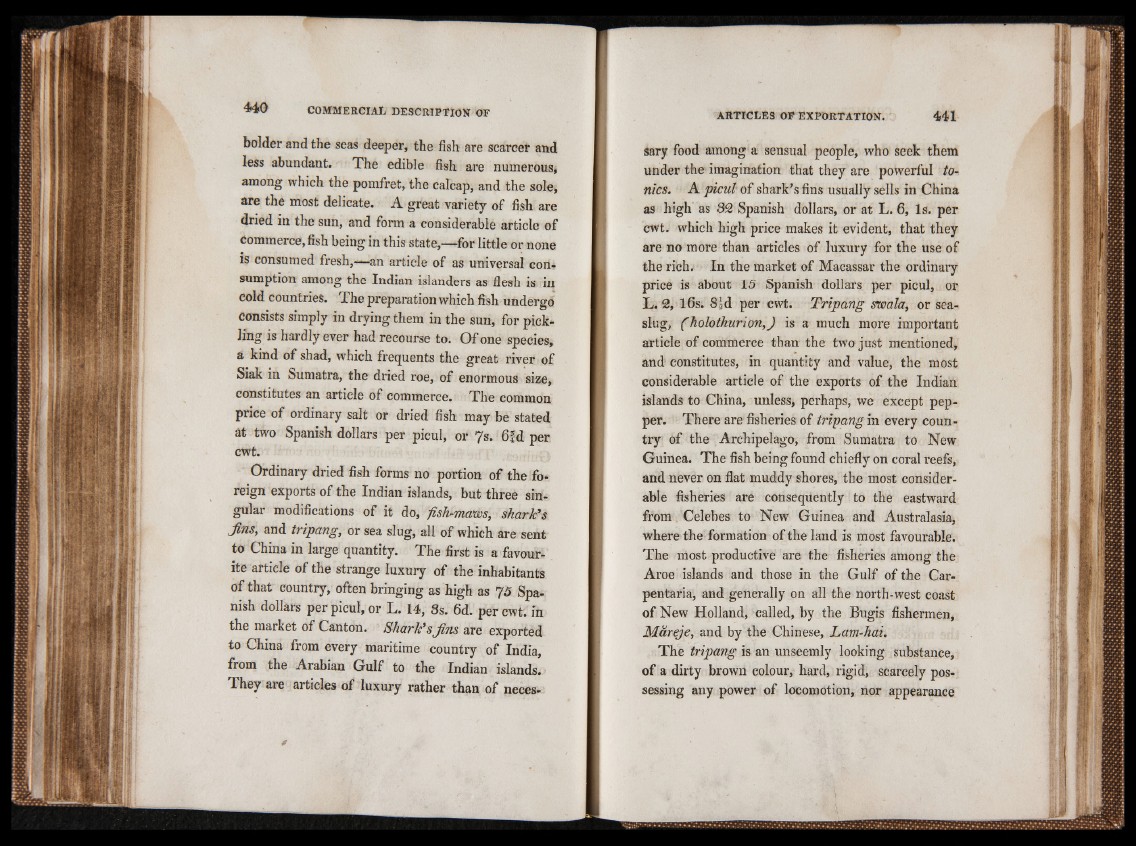
bolder and the seas deeper, the fish are scarcer and
less abundant. The edible fish are numerous,
among which the pomfret, the calcap, and the sole,
are the most delicate. A great variety of fish are
dried in the sun, and form a considerable article of
commerce, fish being in this state,—for little or none
is consumed fresh,-—an article of as universal con*
sumption among the Indian islanders as flesh is in
cold countries. The preparation which fish undergo
Consists simply in drying them in the sun, for pickling
is hardly ever had recourse to. Of one species,
a kind of shad, which frequents the great river of
Siak in Sumatra, the dried roe, of enormous size,
constitutes an article of commerce. The common
price of ordinary salt or dried fish may be stated
at two Spanish dollars per picul, or 7s. 6fd per
cwt.
Ordinary dried fish forms no portion of the fo*
reign exports of the Indian islands, but three singular
modifications of it do, fish-maws, ¡shark’s
fins, and tripang, or sea slug, all of which are sent
to China in large quantity. The first is a favour*
ite article of the strange luxury of the inhabitants
of that country, often bringing as high as 75 Spanish
dollars per picul, or L. 14, Ss. 6d. per cwt in
the market of Canton. Shark’s fins are exported
to China from every maritime country of India,
from the Arabian Gulf to the Indian islands.
They are articles of luxury rather than of necessary
food among a sensual people, who seek them
under the imagination that they are powerful tonics.
A picul of shark’s fins usually sells in China
as high as 32 Spanish dollars, or at L. 6, Is. per
cwt. which high price makes it evident, that they
are no more than articles of luxury for the use of
the rich. In the market of Macassar the ordinary
price is about 15 Spanish dollars per picul, or
L. 2, 16s. 8 |d per cwt. Tripang srvala, or sea-
slug, Cholothurion,) is a much more important
article of commerce than the two just mentioned,
and constitutes, in quantity and value, the most
considerable article of the exports of the Indian
islands to China, unless, perhaps, we except pepper.
There are fisheries of tripang in every country
of the Archipelago, from Sumatra to New
Guinea. The fish being found chiefly on coral reefs,
and never on flat muddy shores, the most considerable
fisheries are consequently to the eastward
from Celebes to New Guinea and Australasia,
where the formation of the land is most favourable.
The most productive are the fisheries among the
Aroe islands and those in the Gulf of the Carpentaria,
and generally on all the north-west coast
of New Holland, called, by the Bugis fishermen,
Mareje, and by the Chinese, Lam-hai.
The tripang is an unseemly looking substance,
of a dirty brown colour, hard, rigid, scarcely possessing
any power of locomotion, nor appearance